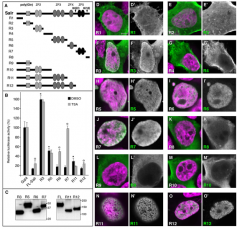
2011/07/07
The activity of SALL transcriptional repressors depends on their HDAC and their SUMOylation status
The SALL (Spalt-like) family of zinc finger transcription factors is conserved throughout evolution and is involved in fundamental biological processes, including stem cell maintenance and carcinogenesis. In humans, mutations in SALL genes are associated to rare congenital diseases such as the Townes-Brocks syndrome or the OS Okihiro, autosomal dominant disorders characterized by limb malformations and renal anomalies.
Drosophila Sall homologues act as transcriptional repressors in Drosophila and in mammalian cells, and that both contain repression and activation domains. Sal and Salr show different repression mechanisms, HDAC dependent and independent respectively, and SUMOylation affects their transcriptional capacity in opposite ways.
These results indicate an intricate regulation of the activity of SALL proteins, which correlate well with their complex function in vivo. Our phylogenetic analysis show conserved boxes among metazoans, which could correlate with repression or activation domains. Based on their high degree of conservation, these novel motifs could be relevant for the function of SALL proteins in vertebrates.
See a large version of the first picture





